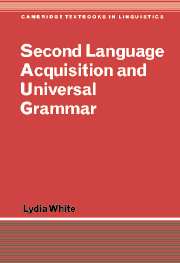Book contents
- Frontmatter
- Contents
- Preface
- Abbreviations
- 1 Universal Grammar and language acquisition
- 2 Principles of Universal Grammar in L2 acquisition
- 3 The initial state
- 4 Grammars beyond the initial state: parameters and functional categories
- 5 The transition problem, triggering and input
- 6 Morphological variability and the morphology/syntax interface
- 7 Argument structure
- 8 Ultimate attainment: the nature of the steady state
- Glossary
- Notes
- References
- Index
5 - The transition problem, triggering and input
Published online by Cambridge University Press: 05 June 2012
- Frontmatter
- Contents
- Preface
- Abbreviations
- 1 Universal Grammar and language acquisition
- 2 Principles of Universal Grammar in L2 acquisition
- 3 The initial state
- 4 Grammars beyond the initial state: parameters and functional categories
- 5 The transition problem, triggering and input
- 6 Morphological variability and the morphology/syntax interface
- 7 Argument structure
- 8 Ultimate attainment: the nature of the steady state
- Glossary
- Notes
- References
- Index
Summary
Introduction
As a number of researchers have pointed out, theories of language acquisition must explain both properties of linguistic representations (the form and nature of the grammar) and transition or development (how and why grammars change over time) (Carroll 1996, 2001; Felix 1986; Gregg 1996; Klein and Martohardjono 1999; Schwartz and Sprouse 1994). In other words, there is a need for a property theory as well as a transition theory (Gregg 1996). In previous chapters, discussion has centred on representational issues such as the nature of the interlanguage grammar, the degree to which the L1 grammar determines interlanguage representations, and the extent to which the interlanguage grammar falls within the class of grammars sanctioned by UG. Indeed, most research on L2 acquisition conducted within the generative framework in the last twenty years has focused on issues of representation, in other words, on a property theory of interlanguage. Clearly, however, interlanguage grammars are not static: they change over time. What remains to be considered is how development takes place, in particular, what drives transition from one stage to another.
The logical problem of language acquisition (see chapters 1 and 2) motivates a particular kind of representational account, an account that assumes built-in universal principles, in other words, UG. Felix (1986) observed that, in the case of L1 acquisition, far more had been achieved at that time in terms of explaining the logical problem than the developmental problem.
- Type
- Chapter
- Information
- Second Language Acquisition and Universal Grammar , pp. 151 - 177Publisher: Cambridge University PressPrint publication year: 2003



